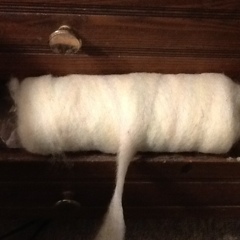This all started with a 4 oz braid of fiber from Natural Obsessions. She started a fiber club using a random tarot card to inspire her dyeing. This was the fiber from the first month of the club. It is dyed 80/20 merino/tussah silk. The card (which I really can't show here) was the 10 of Pentacles. She included a color copy of the card which shows 10 gold stars. It was those stars that I wanted to capture in the final yarn.
After thinking awhile about various possible ways to do that, I finally realized I wasn't going to like anything that didn't just pop with metallic gold. I couldn't stop thinking about that crochet cotton you see with the metal thread as one ply. I had even crocheted snowflakes from some of that type of commercial yarn, and those really did look like gold stars.
So I decided I would spin all of the 4 oz of fiber as a single and try plying with the commercial yarn.
I ended up with a single of 22 WPI. Although I forgot to take a picture of the fiber in it's braid, you can see the way to colors fell and progressed in the final yarn.
I went and bought three balls of the commercial yarn, in a light color with gold threads. I tried the light color with about five yards, and washed the sample, just to see how it would look. The yarn was fine after washing, but there was not enough gold 'pop' to the yarn. So I went to another store and bought three balls of a gold plied with gold thread. That was what I ended up using for this final yarn.
The process took a long time, because my curiousity got the better of me. I spun another fiber into a single and went through my stash and found 12 commercial yarns to ply with that single. It ranged from very thick to laceweight. The results were interesting and I did a podcast about it. I even talked about splitting up those yarns and washing them just to see if it made a difference in the next podcast.
The key point to the whole experiment is you will have the most satisfactory results if the WPI of your handspun and commercial yarn is close to the same. As it turned out that is what happened with this skein of yarn, the hand spun was 22 WPI and the crochet cotton 23 WPI.
These photos show the skein all on the niddy noddy I use, both sides are all part of one skein. Each ball of crochet cotton was 100 yards, based on what I used I should have about 425 yards.











